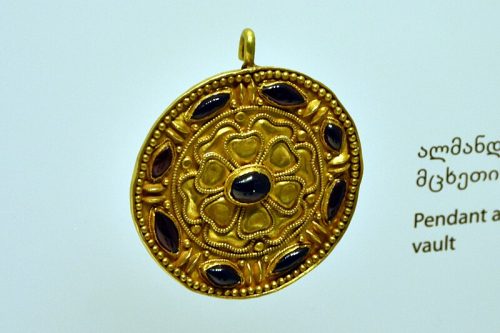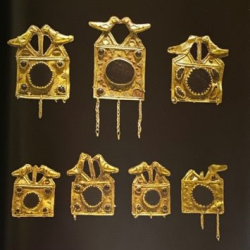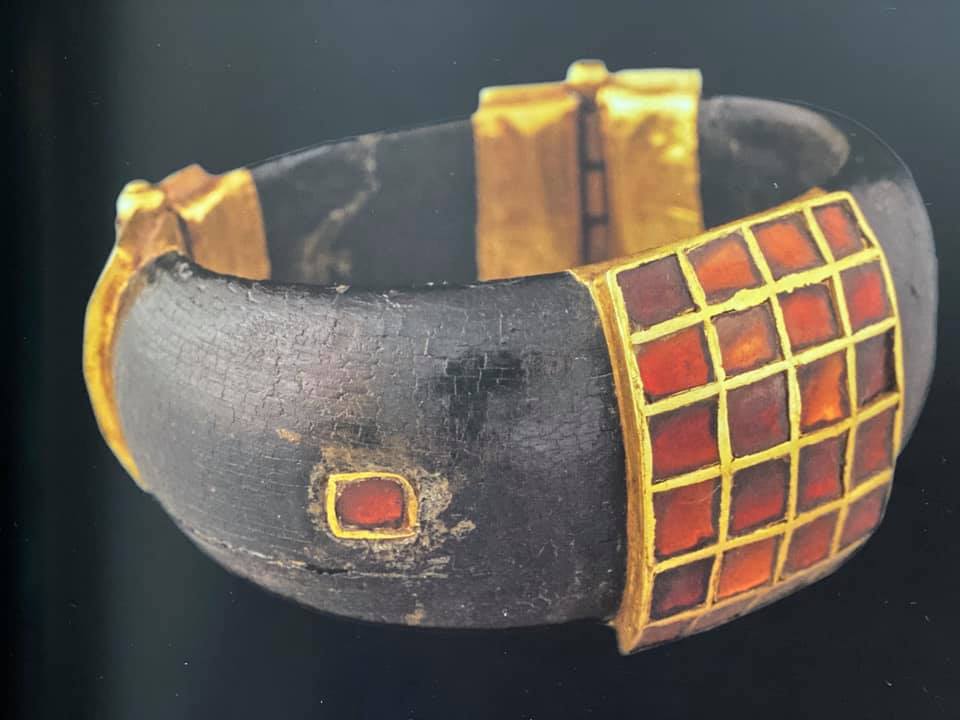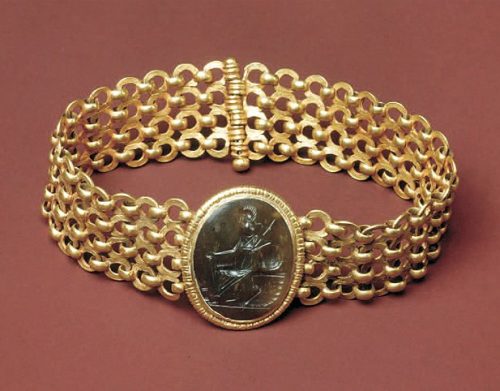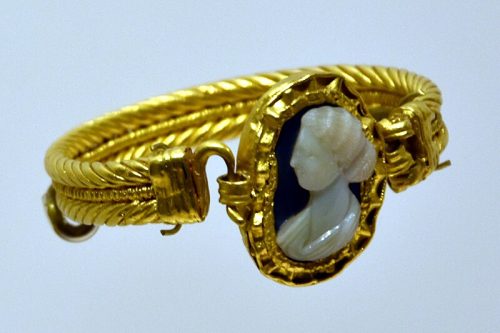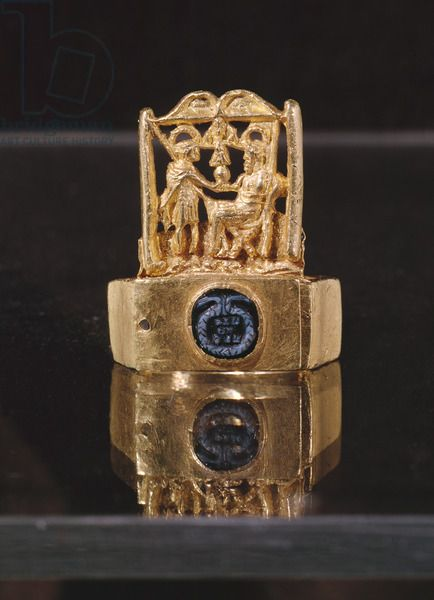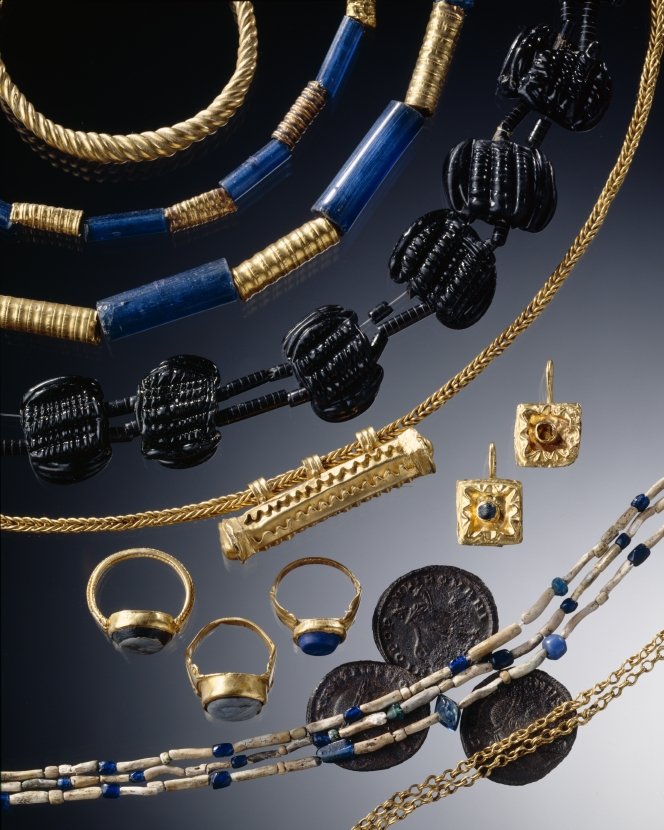For Gonio-Apsaros Roman time hoard see >> https://colorsandstones.eu/2022/03/21/gonio-treasure/
“In Late Classical period, in eastern Georgia production of polychrome ornaments is resumed; samples of this kind of ornaments have been discovered in Samtavro. Colored stones that were the determining aspect of Iberian polychrome ornaments were imported from eastern countries, especially from India. These relations were reflected even on the methods of processing of gold ornaments themselves. First of all, inlaying of colored stones should be mentioned.”
Nino Kobalia, Samples of Georgian Goldsmithery from Samtavro Cemetery

Earrings, gold and garnet.
Armaziskhevi, 2nd-3rd century.
Photo [source]

3rd century, Armaziskhevi

gold, pearl, garnet, glass paste; found in Aghaiani (Shida Kartli)
dated 3rd-4th century
Preserved in the Georgian National Museum. Source – Book “Old Georgian Jewelry”

Earring. Gold, garnet; found in Svetitskhoveli; dated 3rd-4th century
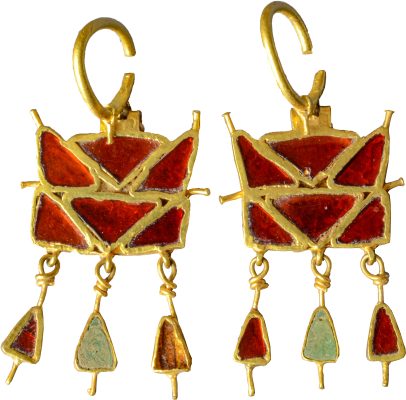
Earrings, gold and glass. Pichvnari, Colcian cemetery. 4.3X1.2 cm
Batumi Archaeological Museum Collection Inv. № 1:12/136, 47-48
“This imported jewellery has open-ends. A plain hoop. Rectangular in shape. The surface adorned with gold threads is incrusted. On the fixed hoops are loosely suspended pendants of triangle shape in threes. The pendants have mounted inlays of red glass with the central part of green glass-like paste. On the upper edges and sides of rectangular hoops, as well as on the bottoms of the triangles once should have been attached short discs with pearls. The back side of the earrings is covered by a plain flat gold platelet. Similar objects have been discovered in Romania.”
Bibliography: Vickers Michael, Kakhidze Amiran, Pichvnari 6, Batumi, 2014: 240-241, figs 145. 7, 146.1.
Also https://www.facebook.com/BatumiArchaelogicalMuseum/photos/a.1897919020305355/2674164792680770/?type=3
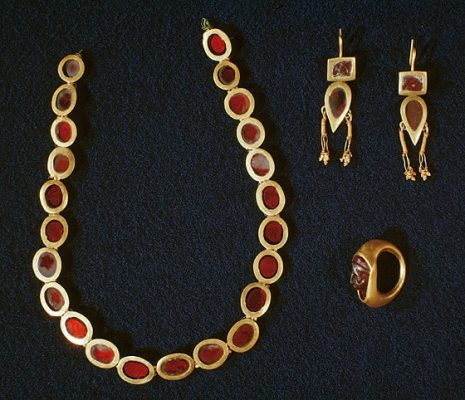
Photo source https://www.facebook.com/gurielgeorgia/photos

Photo source https://www.facebook.com/gurielgeorgia/photos
Jewels with Stone Inlays from Hatra
https://iris.unito.it

https://burusi.wordpress.com/2009/12/23/georgia/

Earrings, gold, glass paste, pearl. Found in Armaziskhevi (Shida Kartli); dated 3rd-4th century. Size – 7.5 cm. Preserved in the Georgian National Museum. Source – Book “Old Georgian Jewelry”

Earrings: gold, garnet, turquoise, pearl. Size 8.5 × 2.5 cm, found in Samtavro (Shida Kartli) dated 2nd-3rd century. Source: “Old Georgian Jewelry” Nino Lortkipanidze

photo source

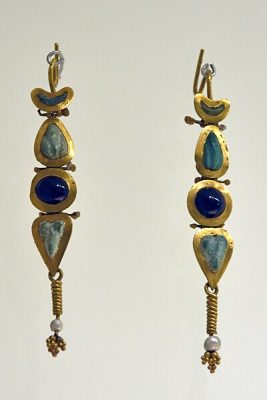
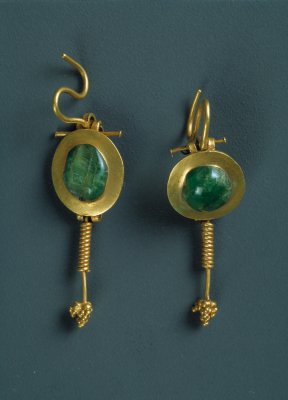
Photo after W. Orthmann
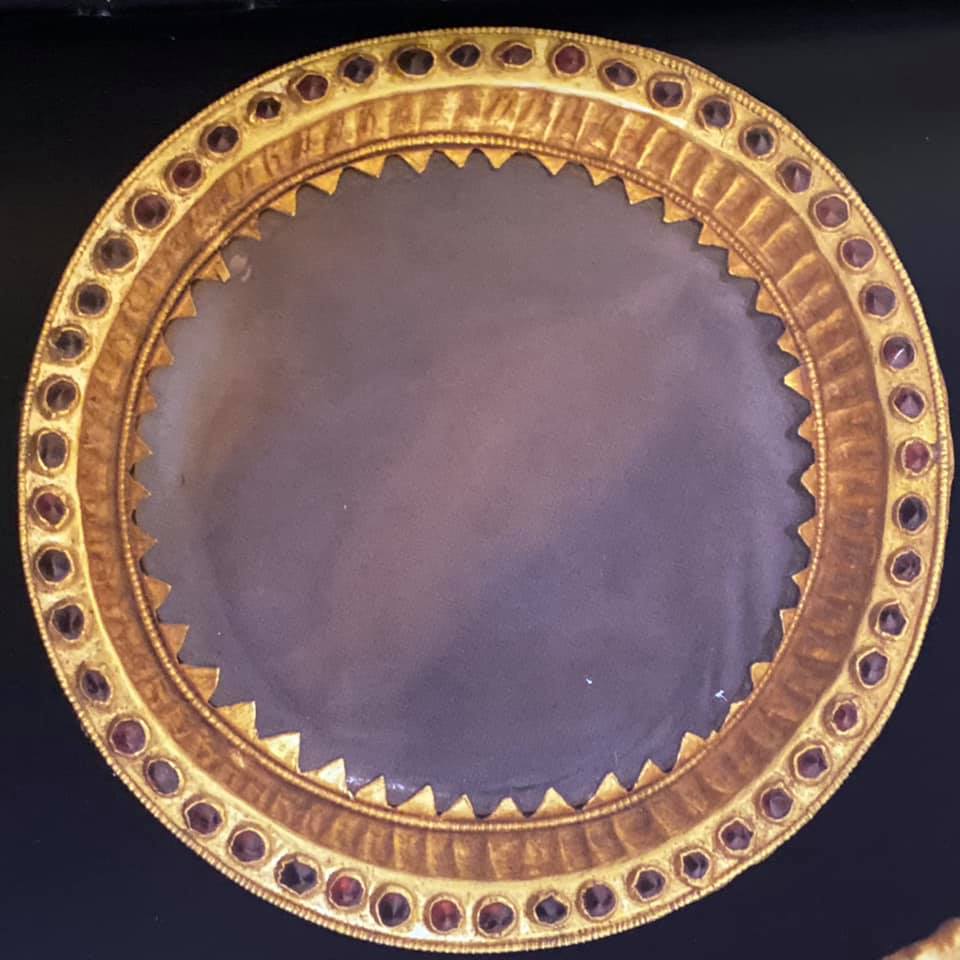
https://www.facebook.com/SakdrisiCommittee
An ornament made of gold, agate, garnet. Diameter 9.3 cm. Found in Armaziskhevi (Shida Kartli), dated 2nd-3rd century. Source: “Old Georgian Jewelry” Nino Lortkipanidze

Brooch, 2nd-1st C BCE; gold, carnelian and shell.
Cossack village Shchedrinskaya, “Chernyshov Burial-mound” – chance find of 1875.
Tbilisi, State Museum of Georgia, inv.-no. 2982
to compare

Ust-Labinskaya stanitsa [Kuban region], “Девять братьев” группа курганов
ГИМ 48478/683
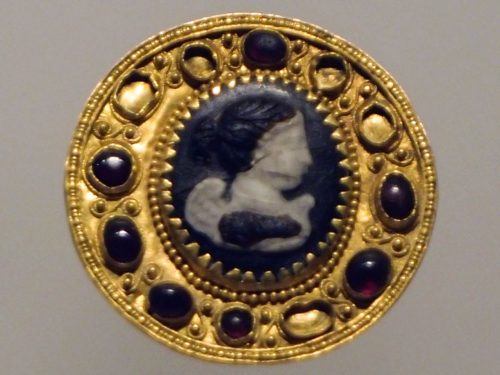
Photo source https://turbinatravels.com

Georgia, Makho, 1st-2nd century
Kept at Batumi Archaeological Museum.
https://www.facebook.com/BatumiArchaelogicalMuseum
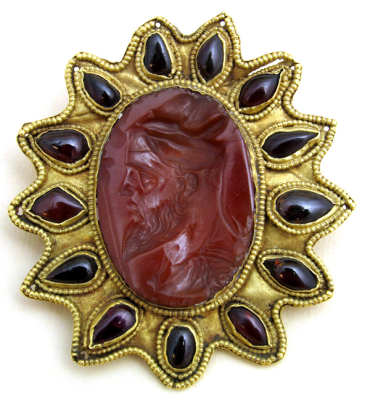
Brooch with a portrait of Colchian man, gold and carnelian intaglio. Village Kldeeti, Zestafoni Municipality, Region Imereti, Georgia; 2nd century
in GNM


https://commons.wikimedia.org
Gold, cornelian, garnet [nett pendants], glass beads. 6×5 cm.
Village Kldeeti, Zestafoni Municipality, Region Imereti, Georgia, 2nd-3rd century
National Museum of Georgia
Ornaments made of gold and garnet, found in Kldeeti (Imereti) and date back to 3rd-4th century. From the 3rd century, samples of cloisonne decoration of precious stones spread throughout Georgia.
See M. Treister, Cloisonné-and champlevé-decoration in the Gold work of the Late Hellenistic-Early Imperial Periods https://www.academia.edu
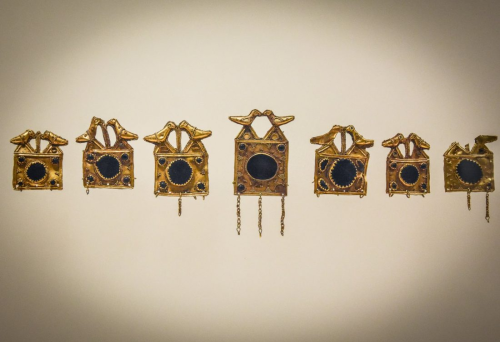

Gold pendant with birds; Kapandipi, 1st century
Photo source https://mkinspires.ru/arheologicheskij-muzej-batumi/

1st century buckle, from Kapandipi, Khelvachauri Municipality, chance find.
Gold, garnet, blue paste. Size: 8X5 cm
Batumi Archaeological Museum Collection Inv. № VI: 06-94/2:
“This local jewellery with bird, attribute of the Mother Goddess made of one piece platelet. The lower half is rectangular in shape, the upper one represents an isosceles triangle. On the sides there are placed wires of false granulation. The top parts are adorned with the double volute-like images. The central part has a denticulated setting filled with a large oval garnet bead. Vacant space is decorated with rosettes, rhombuses, triangles and some globules. The central image of the triangle is represented by a hexagram made of blue paste placed into a plain setting. Vacant space is filled with some globules, a triangle and rosettes. On the right side of the triangle there is placed a bird sculptural image (the second one is lost).”
Bibliography: Kakhidze Amiran, Shalikadze Tamar and Partenadze Tamar, Batumi Archaeological Museum Treasure, Catalogue, Batumi, 2015: 54-55, fig. 70.
BELTS
A belt of Pitiakhsh Asparukh – a governor of Iberia.
The nine inlaid gold medallions and a clasp of a belt found in Armaziskhevi necropolis, tomb I, are dated to the 2nd century. Made of gold the elements are decorated with carnelian, garnet, turquoise.
Armaziskhevi is located near historical town Mtskheta, in Kartli province, in about 20 km from Tbilisi. From the 3rd century BCE to the 5th century CE Mtskheta was the capital of ancient Kingdom of Iberia [Georgia].
From the 1st century local workshops can be found in the region of Tbilisi, where invited masters worked together with the locals. [Source: “Old Georgian Jewelry” Nino Lortkipanidze]
“That the custom of large belt plaques ends with the 1st century AD is affirmed by the ostentatious belt in grave I at Mtskheta. Instead the belt is now decorated with large precious stones.” [Ursula Brosseder, Belt plaques]


Inside the golden buckle of this belt is a garnet intaglio that depicts busts of men and women looking at each other.
There is a Greek inscription around the image, which translates as: Zevakh – my life – Karpak. Karpak is thought to be the name of a man, Zevakhi of his wife.

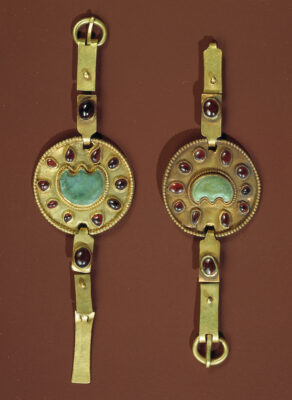
Photo source https://atinati.com

Photo source https://vid1.ria.ru/ig/infografika/kafidov/Sputnik/georgia/diadema/page704447.html
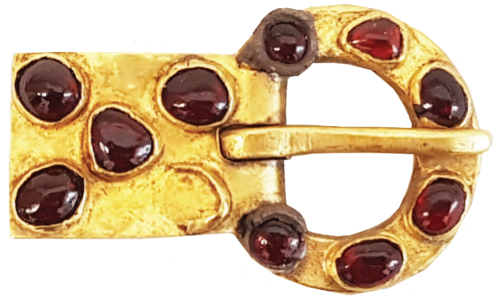

read more

Gold and garnet cloisonné belt and hinged mount or buckle plate, Ureki, 3rd-4th century.
Length of a buckle – 4.8 cm
State Museum of Georgia, Tbilisi
Rethinking the Sutton Hoo Shoulder Clasps and Armour, Noel Adams https://www.academia.edu
ВЕЛИКОЕ ПЕРЕСЕЛЕНИЕ НАРОДОВ В ЗЕРКАЛЕ ПАМЯТНИКОВ ЮВЕЛИРНОГО ИСКУССТВА, Фурасьев А.Г., p. 28, Hermitage 2016



3rd century clasps, from the Armaziskhevi necropolis. Made of gold with turquoise and garnet. [Noel Adams, Rethinking]
Belt plaques. Gold, sardonyx; found in Samtavro burial ground, Mtskheta; 3rd century
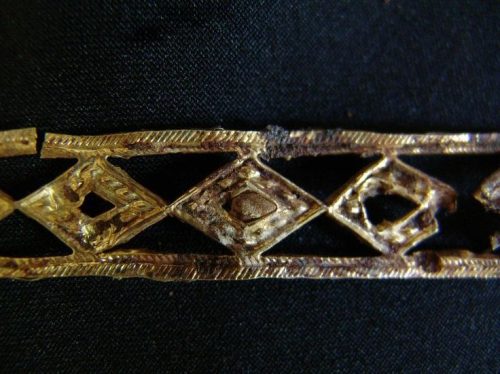
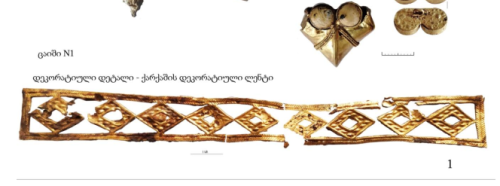
THE TECHNOLOGICAL DETAILS OF MANUFACTURING THE PRECIOUS METAL ARTEFACTS OF PRE- CLASSICAL PERIOD; Nino Kobalia in:
Journal: IBERIA-COLCHIS no 17 [2023]
Gela Gamkrelidze https://www.academia.edu
BRACELETS
2nd century bracelet from Mtskheta. Jet, Gold, Garnet, Glass. Museum of Georgia >> http://museum.ge
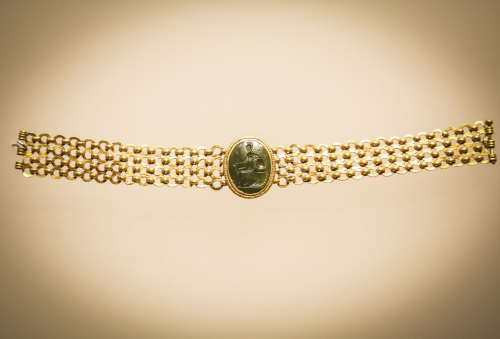
Pair of gold bracelets with the cameo. Was found in the burial to the south of Samtavro necropolis (Mtskheta municipality). Dated 3rd century. Preserved – Georgian National Museum


Gold bracelet made of hollow tubes, with hinges and a central medallion; 1st century. From the Queen’s Field Complex, near Aradeti. The place was a complex of temples (10+), priestly and slave craftsmen buildings, cemeteries and workshops.
Compare with a bracelet from Maykop [pic. on the right]

Coast of Krasnodar Reservoir, Maykop

Bracelets [two pairs]: gold, enamel, garnet. Dim. 21 × 2.7 cm, found in Armaziskhevi (Shida Kartli), dated back to the 3rd-4th century.
Source: “Old Georgian Jewelry” Nino Lortkipanidze

https://commons.wikimedia.org/wiki/File:Armaziskhevi_bracelet.JPG

Photo by Jonathan Cardy
https://commons.wikimedia.org/wiki/File:Almandine_bracelet.jpeg

gold ankle bracelet from Armaziskhevi, 2nd century CE
NECKLACES

Necklace, Gold, garnet, found in Svetitskhoveli
dates back to the 2nd century
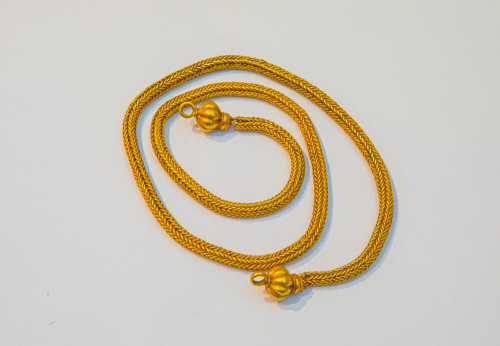
Size: 62.5X1.5 cm. Gold
https://ajaramuseums.ge/en/museums/arch/Chain%20%201st%202nd%20centuries%20AD
This massive object made of eight braided wires that form coniferous-like ornament in four rows. Both ends terminate in fluting spherical globules and hoops soldered to them. The coincidence part is adorned with three hoops. According of investigators of the hoard, not excluded that a statue of the golden youth was hanging over it (see: Lordkipanidze Otar, Mikeladze Teimuraz et Khakhoutaichvili David, Le Trèsor de Gonio, Tbilissi, 1980: 74).
Batumi Archaeological Museum Collection Inv. № 1: 12-106
Bibliography:
Lordkipanidze Otar, Mikeladze Teimuraz et Khakhoutaichvili David, Le Trèsor de Gonio, Tbilissi, 1980: 18, pls 51-52; Kakhidze Amiran, Shalikadze Tamar and Partenadze Tamar, Batumi Archaeological Museum Treasure, Catalogue, Batumi, 2015: 96, fig. 96.


This necklace was made in the 3rd century and it has typical Roman setting of the pendant. It is made of gold with an amethyst intaglio depicting a man looking like Emperor Caracalla. Pendant with pearl(?) is missing. Found in Urbinisi village, district of Kareli
GNM, Simon Janashia Museum of Georgia.

Medallion. Tsilkani, Mtskheta region, 1st-2nd century
Gold, amethyst, pearl, 6.9 x 2.4 cm. Museum of Georgia

read more

Photo source https://commons.wikimedia.org


second photo https://commons.wikimedia.org
Necklace with sardonyx cameo, a nereid riding a dolphin, end of the 2nd century.
“Hadrian online” Georgia in Roman times, pp. 157
https://webarchive.nationalarchives.gov.uk/20190801113240/https://www.britishmuseum.org/pdf/Hadrian_online.pdf



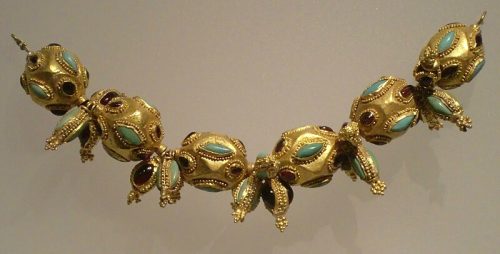
https://commons.wikimedia.org/wiki/File:Pyrope_and_Turquoise_jewellery.JPG
RINGS

Mtshketa, burial of a 40-50 y/o woman; 3rd-4th century
A gold seal ring with a sardonyx intaglio, with an image of a woman wearing “Phrygian hat”, with a Greek inscription: “Queen Ulpia the Lord”.

Mtskheta, 2nd-3rd century
https://museum.ge/index.php?m=305&cid=121&col_id=989
Pectoral from Vani, 4th century BCE


Imereti, Vani, 4th C BCE

Gold bracelets from Vani, 4th century BCE

Gold bracelets from Vani, 4th century BCE
Massive golden arm rings ended with animal heads shaped by lions, bulls, rams or boars; some of them are made in the so-called Achaemenid style.

Gold necklaces from Vani, 4th century BCE

Gold boar bracelets from Vani, 5th Century BCE

Earrings from Vani, 4th century BCE

Earrings from Vani, 4th century BCE

Plates in relief, gold, Sadseguri, 4th cent. BCE

Gold earrings, Pichvnari,
5th century BCE

Pendant, gold, Sadseguri, 4th century BCE

decorative disc, gold,
Sadseguri, 4th C BCE

Gold ring, Pichvnari,
5th century BCE

Perfume bottles, glass, Pichvnari,
5th century BCE

Gold phiale from Vani, 4th century BCE
SOURCES
- Archaeology of the Roman Period Georgia (essay & catalog) Gela Gamkrelidze
- RESEARCHES IN IBERIA-COLCHOLOGY (History and archaeology of ancient Georgia) by Gela Gamkrelidze http://museum.ge
- M. Treister, Gala Phalerae from the Cache in the Sarmatian Burial Mound No. 1/1985 near the Settlement of Dachi (the Vicinities of Azov) https://www.academia.edu
- M. Treister, Cloisonné-and champlevé-decoration in the Gold work of the Late Hellenistic-Early Imperial Periods https://www.academia.edu
- Belt Plaques as indicator of East West relations, Ursula Brosseder https://www.academia.edu
- Rethinking the Sutton Hoo Shoulder Clasps and Armour, Noel Adams https://www.academia.edu
- Unterwegs zum goldenen Vlies. Archäologische Funde aus Georgien, Winfried Orthmann https://www.academia.edu
- ВЕЛИКОЕ ПЕРЕСЕЛЕНИЕ НАРОДОВ В ЗЕРКАЛЕ ПАМЯТНИКОВ ЮВЕЛИРНОГО ИСКУССТВА, Фурасьев А.Г., p. 28, Hermitage 2016
- “Hadrian online” Georgia in Roman times, pp. 157 https://webarchive.nationalarchives.gov.uk
- “Colchis women did not lag behind fashion” an article by Eter Eradze
- Nino Kobalia, Samples of Georgian Goldsmithery from Samtavro Cemetery. Collections of Georgian National Museum. Interdisciplinary study. 2019
- http://museum.ge/index.php?lang_id=GEO&sec_id=121&info_id=1001
- http://museum.ge/files/broshurebi/Museum_Broshura_A4_ENG_WEB.pdf
- An Aramaic amulet from Mtskheta http://vdi.igh.ru/system/articles/pdfs/000/001/791/original/2fd256e67d98b4885198d6458b0aad94ee2a0dec.pdf?1531144530


https://dzieje.pl/aktualnosci
Silver coin of Julia Domna (reverse) discovered in the Roman fort Apsaros, Georgia. From the treasure of silver & bronze coins minted between the reign of Hadrian (117-138), and Septimius Severus (beginning of the 3rd century). All coins were minted in Caesarea, 1000 km from Apsaros.

